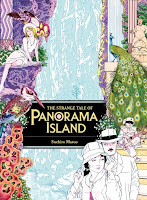 Author: Edogawa Rampo
Author: Edogawa Rampo
Translator: James B. Harris
U.S. publisher: Tuttle
ISBN: 9784805311936
Released: May 2012
Original release: 1924-1950
After reading and enjoying Edogawa Rampo’s novella Strange Tale of Panorama Island I decided to seek out more of his work. What better way to start than with Rampo’s debut in English? Japanese Tales of Mystery and Imagination, translated by James B. Harris and first published in 1956, was reissued in 2012 by Tuttle Publishing with an additional and quite useful foreword by Patricia Welch putting the collection and Rampo into historical and literary context. Despite Rampo’s prolificacy, influence, and popularity in Japan, relatively few volumes of his work are available in English although his short stories can often be found in anthologies. In addition to being Rampo’s introduction to English-reading audiences, Japanese Tales of Mystery and Imagination is particularly interesting in that Rampo worked very closely with Harrison on its translation.
Japanese Tales of Mystery and Imagination collects nine of Rampo’s short stories selected to represent some of his best work. Eight of the nine stories were originally written in the 1920s. The collection opens with what is perhaps Rampo’s most well-known story “The Human Chair.” (At least, it was the story with which I was most familiar before reading the volume.) Next is “The Psychological Test” which features Rampo’s famous detective Kogorō Akechi. “The Caterpillar” is another story I was previously aware of and for a time was even banned in Japan. The collection continues with “The Cliff.” Written in 1950, it is the most recent example of Rampo’s work in the volume. Other tales of mystery include “The Twins,” “The Red Chamber,” and “Two Crippled Men” while other tales of imagination include “The Hell of Mirrors” and “The Traveler with the Pasted Rag Picture.” Though, as Welch points out in the foreword, Rampo frequently blurs the lines of genre and many of the stories have significant crossover.
Rampo is an incredibly clever and imaginative writer. Even when working with similar themes and plot elements, each story in Japanese Tales of Mystery and Imagination exhibits Rampo’s creativity in narrative technique and structure and he throws in enough plot twists that they all feel fresh. Each story is a little peculiar and each story is vaguely disconcerting—the erotic and the grotesque and macabre are no strangers to Rampo’s work—but in the end the tales are all different from one another. The culprits of his crimes stories are often undone by their arrogance, belief in their infallibility, or on occasion their guilty consciences, but the paths to their downfalls vary. Rampo’s more fantastic tales rely on subtle and not so subtle horror, but their thrills and terrors are all distinctive.
Japanese Tales of Mystery and Imagination is a captivating collection of short stories and would make a fine introduction to Rampo’s work for the uninitiated. If I had to choose, I think that I personally prefer Strange Tale of Panorama Island and its outrageousness slightly more, but the selections in Japanese Tales of Mystery and Imagination show evidence of the elements in the novella that I particularly enjoyed: the tight plotting, the light style of narration with slight touches of humor, the unexpected turns in the story, the inherent strangeness of the characters and their accounts. Japanese Tales of Mystery and Imagination has stood the test of time well. Nearly fifty years after it was first released, and more than a half-century since the stories were originally written, the volume remains an intriguing and engaging collection.


